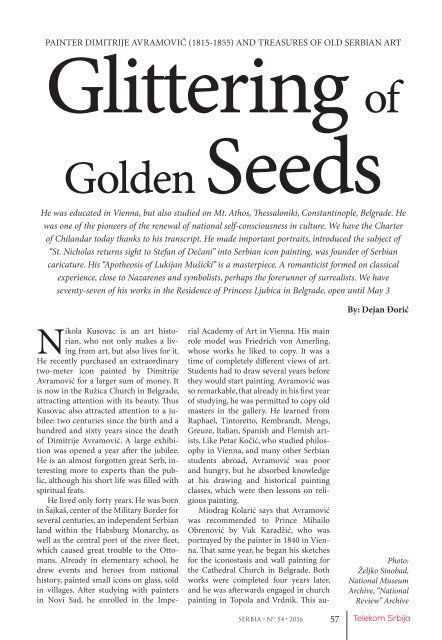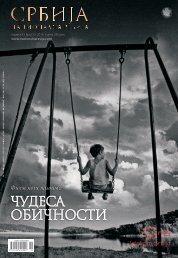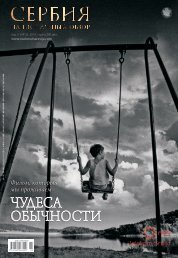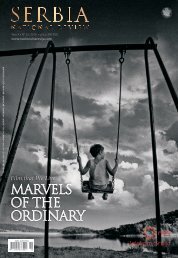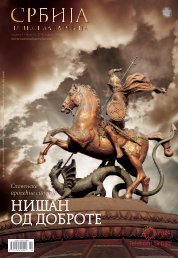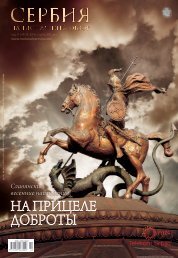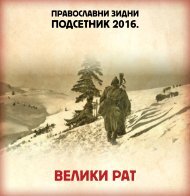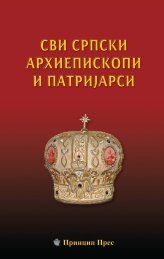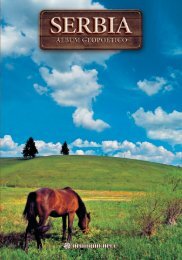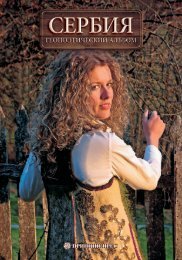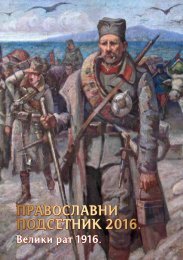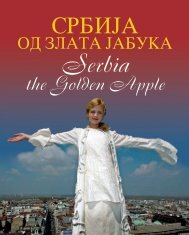Srbija - nacionalna revija - broj 54 - engleski - niska rezolucija
You also want an ePaper? Increase the reach of your titles
YUMPU automatically turns print PDFs into web optimized ePapers that Google loves.
PAINTER DIMITRIJE AVRAMOVIĆ (1815-1855) AND TREASURES OF OLD SERBIAN ART<br />
Glittering of<br />
Golden Seeds<br />
He was educated in Vienna, but also studied on Mt. Athos, Thessaloniki, Constantinople, Belgrade. He<br />
was one of the pioneers of the renewal of national self-consciousness in culture. We have the Charter<br />
of Chilandar today thanks to his transcript. He made important portraits, introduced the subject of<br />
“St. Nicholas returns sight to Stefan of Dečani” into Serbian icon painting, was founder of Serbian<br />
caricature. His “Apotheosis of Lukijan Mušicki” is a masterpiece. A romanticist formed on classical<br />
experience, close to Nazarenes and symbolists, perhaps the forerunner of surrealists. We have<br />
seventy-seven of his works in the Residence of Princess Ljubica in Belgrade, open until May 3<br />
By: Dejan Đorić<br />
Nikola Kusovac is an art historian,<br />
who not only makes a living<br />
from art, but also lives for it.<br />
He recently purchased an extraordinary<br />
two-meter icon painted by Dimitrije<br />
Avramović for a larger sum of money. It<br />
is now in the Ružica Church in Belgrade,<br />
attracting attention with its beauty. Thus<br />
Kusovac also attracted attention to a jubilee:<br />
two centuries since the birth and a<br />
hundred and sixty years since the death<br />
of Dimitrije Avramović. A large exhibition<br />
was opened a year after the jubilee.<br />
He is an almost forgotten great Serb, interesting<br />
more to experts than the public,<br />
although his short life was filled with<br />
spiritual feats.<br />
He lived only forty years. He was born<br />
in Šajkaš, center of the Military Border for<br />
several centuries, an independent Serbian<br />
land within the Habsburg Monarchy, as<br />
well as the central port of the river fleet,<br />
which caused great trouble to the Ottomans.<br />
Already in elementary school, he<br />
drew events and heroes from national<br />
history, painted small icons on glass, sold<br />
in villages. After studying with painters<br />
in Novi Sad, he enrolled in the Imperial<br />
Academy of Art in Vienna. His main<br />
role model was Friedrich von Amerling,<br />
whose works he liked to copy. It was a<br />
time of completely different views of art.<br />
Students had to draw several years before<br />
they would start painting. Avramović was<br />
so remarkable, that already in his first year<br />
of studying, he was permitted to copy old<br />
masters in the gallery. He learned from<br />
Raphael, Tintoretto, Rembrandt, Mengs,<br />
Greuze, Italian, Spanish and Flemish artists.<br />
Like Petar Kočić, who studied philosophy<br />
in Vienna, and many other Serbian<br />
students abroad, Avramović was poor<br />
and hungry, but he absorbed knowledge<br />
at his drawing and historical painting<br />
classes, which were then lessons on religious<br />
painting.<br />
Miodrag Kolarić says that Avramović<br />
was recommended to Prince Mihailo<br />
Obrenović by Vuk Karadžić, who was<br />
portrayed by the painter in 1840 in Vienna.<br />
That same year, he began his sketches<br />
for the iconostasis and wall painting for<br />
the Cathedral Church in Belgrade. Both<br />
works were completed four years later,<br />
and he was afterwards engaged in church<br />
painting in Topola and Vrdnik. This au-<br />
Photo:<br />
Željko Sinobad,<br />
National Museum<br />
Archive, “National<br />
Review” Archive<br />
SERBIA • N O <strong>54</strong> • 2016<br />
57


